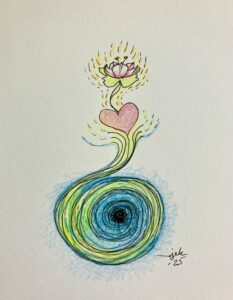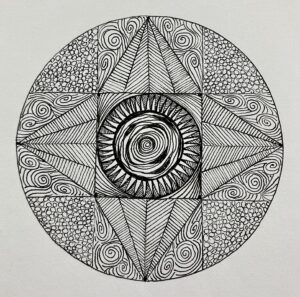
-Artwork © 2025 Jan Ketchel
A shamanic journey is a journey into the unknown of the self, and beyond the self, into the quantum field of infinite possibility. The gateway between the known and the unknown is heavily guarded and must be shattered if we are to create the space needed to accommodate the ever-active growth imperative of our being. Now is the time of that shattering on a collective scale.
The works of Carlos Castaneda have been my spiritual mainstay for the past fifty years. My journey in that world reflects the journey our entire world is currently embarking upon.
When Carlos broke with the secrecy of all shamanic traditions in the early 1990’s, by coming out of hiding and giving away all of his hidden and protected ancient knowledge, my wife Jeanne and I jumped in and became saturated in the shattering practices of his shamanic line.
The threat of death hovered over Jeanne and me, as well as over Carlos and his shamanic line at that time. Jeanne was challenged with breast cancer, Carlos with severe diabetes, and his unique Toltec shamanic line with facing its end, as Carlos’s impending departure loomed. Shamans credit death as one’s true advisor and one’s supreme motivator in this life in human form.
Carlos had been told by his mentor, the nagual don Juan Matus, that his energetic configuration was only capable of endings, not continuation. However, Spirit had also shown don Juan that the world was on the precipice of a major shift and that it was time to hand over the wisdom of his shamanic line to the coming “age of information”, where it could inform and transform in new, modern ways.
Carlos’s teaching methods were radical and completely shattering of the social order. Many people gave up their careers, relationships, and even their names to make available space in their lives to dedicate themselves to the practices that prepared them to journey into infinity on demand.
If we want to grow, we must make space for growth. We must release, rather than hoard, old attachments to withered beliefs and lifestyles that preclude living life in the freedom of innocence and new possibility.
Jeanne and I were on this shamanic journey of preparation for infinity, as well as on a simultaneous journey for healing that would keep her in this world. Ultimately, it was her definitive journey into infinity that won out. She launched in her energy body in 2001, as her physical body gave way to death. Our preparation for this launch, through the shaman’s world, has led to a stupendous, ever-unfolding collaboration between worlds, continuing to this day.
Carlos himself left this world in 1998, and, though his students continued the trainings, in the organization he had established to disseminate his knowledge, that effort has largely lost momentum. In leaving this world, Carlos successfully closed the door on that old modality of transmission, much as don Juan had anticipated. The many thousands of practitioners who had participated in his trainings took their points of illumination forward into their own lives, evolving his line in unique and novel ways.
Personally, I took the shamanic practice of recapitulation into the consulting room, combining it with EMDR. Coming straight out of the shaman’s world, I worked with Jan, for three years, on her journey of recapitulation, which led to her complete healing from complex PTSD.
Jan detailed her journey of soul retrieval from sixteen years of sexual abuse in her five-volume Recapitulation Diaries series, gifting the world a detailed accounting of a shattering journey of total healing but also the realization of a comfortable access to life in infinity. Twenty-three years ago, Jan established regular communication with Jeanne, which she continues to document and publish on our website, as daily Soulbytes, or guidance from infinity.
Our new United States president, like Carlos Castaneda, resembles the trickster shaman, whose job it is to shatter the social order of the world. He was chosen by the majority.
I know that Gaia is a sentient being, quite capable of flicking from her skin anything that does not serve her own evolution. Gaia, as the Earth, is no victim. The current intent of the new government in some way is leading to her advancement.
It seems counterintuitive to have a male-dominated, oligarchical and materialist orientation dominating the world, and supposedly leading to positive evolution, but Gaia, like the subconscious mind, has her own path of heart, though it may come, at this stage of shattering, as the path of heartbreak.
I know that progress ultimately requires that this domination of the masculine ego, at the solar plexus chakra, must be shattered and rise to the heart center. I have confidence that the ways of Gaia will ultimately get us there.
Furthermore, I know that humanity’s next evolutionary step will incorporate greater access to, and integration with, infinity, the fourth dimension. As I learned in the shaman’s world, the refinement of materialism into spirit life, while still in human form, has the potential to vastly shift humankind’s relationship with the Earth, both through lightness of communication and travel. Telepathy and out-of-body travel require no fossil fuels.
Our collective shamanic journey of now is indeed at the stage of heightened shattering of all that we have known, but it is truly just clearing the way for a new foundation for our continued path of heart.
Hold this broader view as we fasten our seatbelts. And, finally, know that life never ends, it only changes vehicles.
With total optimistic innocence,
Chuck
Inspirational interviews that informed this blog:
David Whyte on the Tim Ferris Podcast
Nyei Murez, one of my former teachers in Carlos Castaneda’s world, on Guru Viking:
Episode 50: Scribe of Carlos Castaneda
Episode 54: The Art of Dreaming
Ky Dickens: Telepathy Tapes




